The Google Pixel 4 XL Review: Stuck In The Past In 2019
by Andrei Frumusanu on November 8, 2019 11:30 AM EST- Posted in
- Mobile
- Smartphones
- Pixel 4
- Pixel 4 XL
Display Measurement
The display of the Pixel 4 is one of the phone’s main features thanks to the 90Hz refresh rate. As mentioned in the introduction, the displays on the Pixel 4 series this year is again dual-sourced between LG and Samsung. The regular Pixel 4 receives an LG panel, while the 4 XL that we’re testing and reviewing today, uses a Samsung display.
Android Q promised to have implemented a new iteration of Google’s colour management system, and for the first time, the Photos app is actually able to properly display wide gamut pictures. Unfortunately, it’s still a very limited system in apps as they cannot display differing gamut pictures side-by-side, so for example the thumbnail view is shown only in sRGB. Most importantly, Chrome by default still doesn’t support wide-gamut content as you have to force it in the engine settings, and this implementation doesn’t use the OS’s CMS handling.
We move on to the display calibration and fundamental display measurements of the Pixel 4 XL screen. As always, we thank X-Rite and SpecraCal, as our measurements are performed with an X-Rite i1Pro 2 spectrophotometer, with the exception of black levels which are measured with an i1Display Pro colorimeter. Data is collected and examined using SpectraCal's CalMAN software.

Starting off with the brightness, the Pixel 4 XL is relatively conservative as it peaks out at 438 nits in all scenarios. It’s again very odd here as Google can’t seem to make up its mind on whether it wants to offer an auto-brightness boost or not. Last year, the Pixel 3 only had it available in its Adaptive mode, whilst this year the Pixel 4 doesn’t offer it all, even though the display drivers actually has the high-brightness mode implemented.
In terms of greyscale calibration and accuracy, on my unit things differed greatly based on brightness. At maximum brightness, the Pixel 4 XL was seemingly quite accurate with good colour balance and gamma reproduction. At our standard 200cd/m² measurement point however, things are quite worse. First off, all there’s a more notable colour shift towards greens on the unit which isn’t great. Following that, there’s also creeping issues with the gamma calibration as it’s non-linear and deviates a lot more from the 2.2 target. What this results in is some shades, especially at the higher levels, appear darker than they should be.
I’ve also noted and captured some sort of bug in the display behaviour; when I was measuring at minimum brightness, I encountered some really bad results. I’ve seen this mentioned by some other reviewers and the issue went away when I toggled the screen refresh rate. The odd thing though, is that I wasn’t able to immediately reproduce it afterwards and results on the new measurements were quite ok. The colour shift the phone took was extremely noticeable at the time the bug took place.

SpectraCal CalMAN
"Natural" Greyscale colours

In terms of dE2000, the biggest culprit to the average 2.29 result for me is the green tint of whites as well as the slightly off gamma.
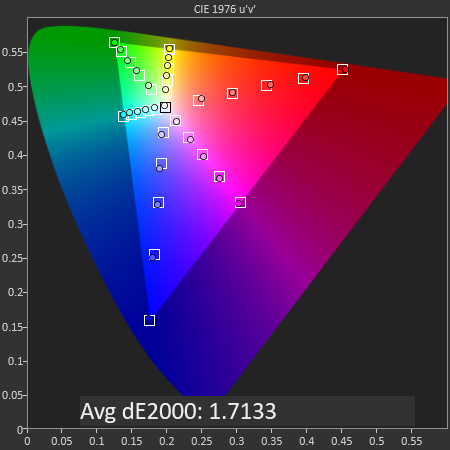
SpectraCal CalMAN
sRGB Gamut
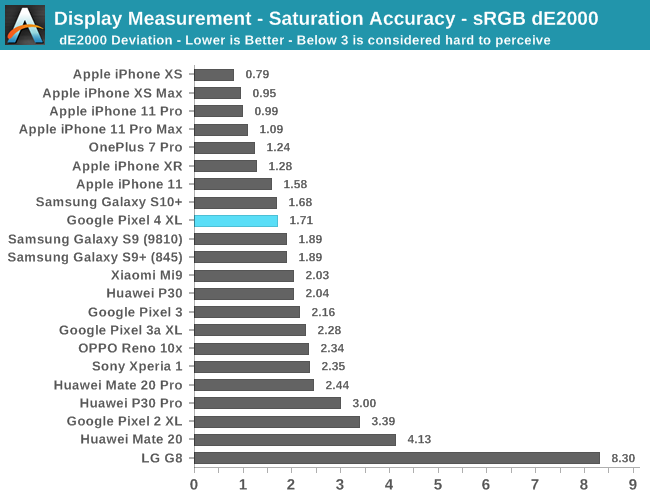
In the sRGB gamut, the Pixel 4 XL does well with a dE2000 of 1.71. The biggest issue again is a shift in the tones towards green, but also seemingly very slight oversaturation of all the tones.
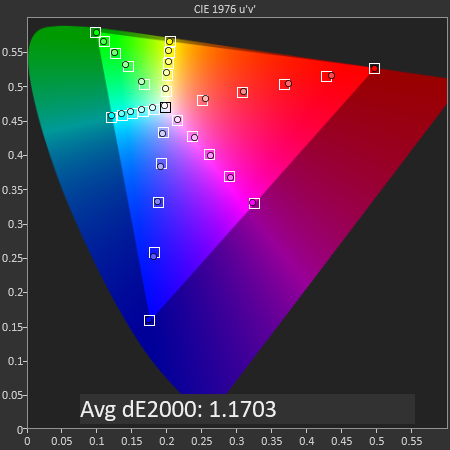
SpectraCal CalMAN
Display P3 Gamut
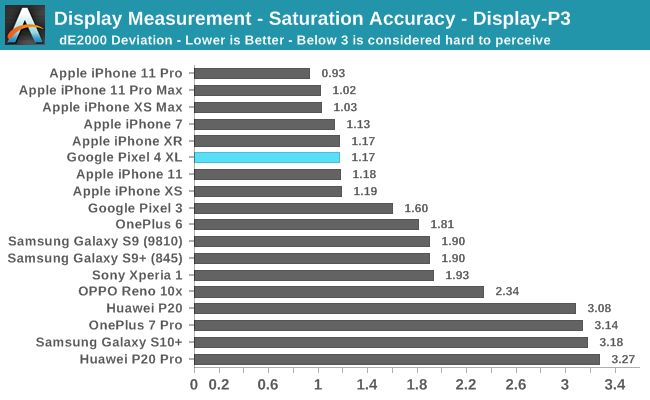
The Display P3 gamut performs a lot better. Here while the green tint is still present, the saturation levels are better and thus the Pixel 4 XL ends up with an excellent dE2000 of 1.17.

SpectraCal CalMAN
Gretag-Macbeth

Finally, in the GMB test, the Pixel 4 XL ends up quite average with a score of 2.34 as it’s showcasing tones that are too dark, a green tint in the whites, with some hue errors for a few tones.
Display Conclusion – Good, but not A+
Overall, the Pixel 4 XL’s display characteristics beyond it’s 90Hz refresh rate are quite average. Whilst Google has been able to improve the calibration compared to what we measured on the regular Pixel 3 last year and the 2 XL the year before that, it’s still quite a bit behind what some other vendors are able to achieve. The display’s lower brightness is also a bit of an issue in direct sunlight as it lacks any kind of boost behaviour. Finally, the remaining characteristics such as viewing angles and sharpness are excellent, but that’s just generally a common characteristic of panels with these specifications.
The results today aren’t really a surprise to me given Google’s track record with the displays on the Pixel series, however it does stand in contrast to what the company was proclaiming at launch: “A+ rating Best Smartphone Display Awards” really doesn’t mean anything at all if, first of all, it’s a sponsored award, and secondly, if the measurements aren’t representative of a random production unit. Make of it what you will.


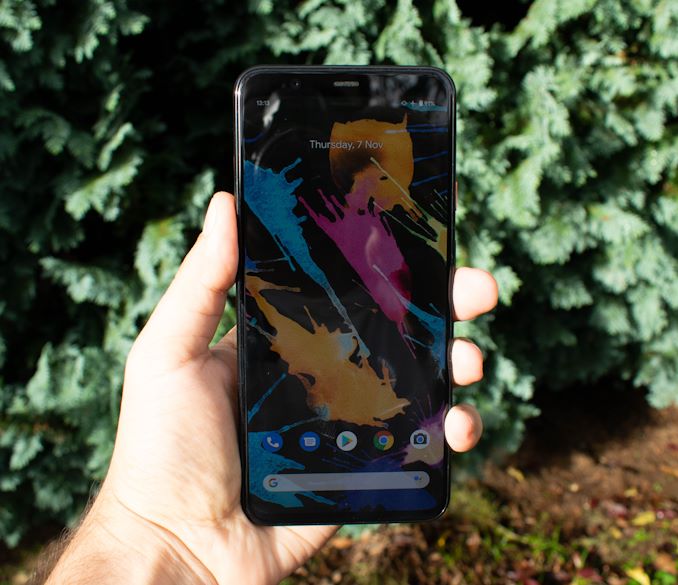
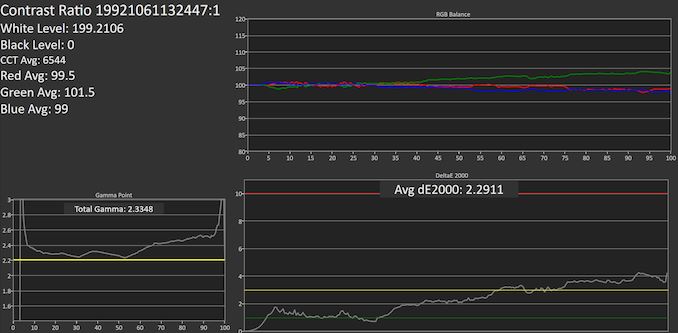
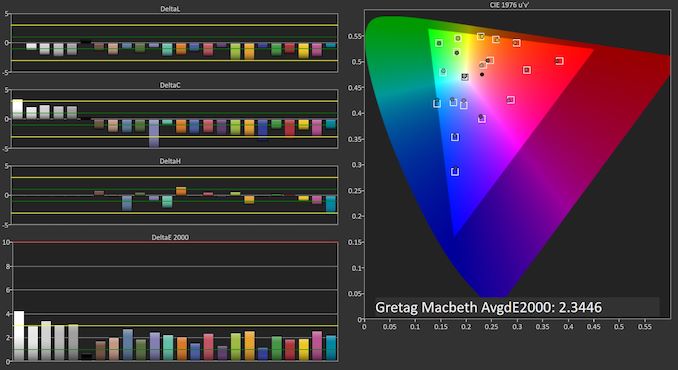








159 Comments
View All Comments
LiverpoolFC5903 - Wednesday, November 13, 2019 - link
Please do not regurgitate unfounded "views" as a fact. The 'new' Nokia has a significant number of people from the 'old' Nokia and is 100% Finnish. This allegation of being a chinese shell is laughable. If you are referring to Nokia phones being manufactured in China, ahem, even Iphones are manufactured in China. As are hundreds of other brands...Spunjji - Monday, November 11, 2019 - link
Pretty sure their bigger problem was being tied to a Microsoft OS.milkywayer - Friday, November 8, 2019 - link
The battery is so terrible that I have the 90hz feature and the hand gesture thingy turned off on my 4XL. Frankly some Google execs need to be in jail for bundling such a terrible battery with a $1000 phone. It should be a crime in 2019 for what they offer for the price tag. Since Ive left Apple, they probably caught the lazy fewks at Google off guard. What a year! APPLE bundling a bigger battery and improved battery life than any one else.s.yu - Friday, November 8, 2019 - link
*Gasp*A LIVE user!
milkywayer - Friday, November 8, 2019 - link
Not sure what you're attempting but if you're gonna post a comment, stick to the topic. There's already enough meaningless spam to go around in the internet.s.yu - Saturday, November 9, 2019 - link
What I mean is somebody reading Anandtech actually buys this crap. The specs and pricing alone should be ample deterrent.milkywayer - Saturday, November 9, 2019 - link
I was going to cancel my ore order. I got mine for $300 off by chance so I took it. I think it's every bit worth the $650ish incl tax i paid for the XL. Googles problem is they are pricing these as iPhones but have cut so many features. I'm sure with the ass kicking they've received now for the pixel 4 at least next year the pixel will have a bigger battery. :Ds.yu - Sunday, November 10, 2019 - link
If $650 inc. tax also covers warranty then...I suppose it's still up for consideration, just not for many here who don't want to put too much personal data on clouds because of the puny storage.Spunjji - Monday, November 11, 2019 - link
At that price it's a reasonable phone. Marginally worse hardware than the competition, better software support.Shame they actually don't sell it for that, otherwise I'd consider buying one!
chrnochime - Tuesday, November 12, 2019 - link
They will just mess up something else next year. They just can't compete at this price level with the seemingly half-baked products they release.